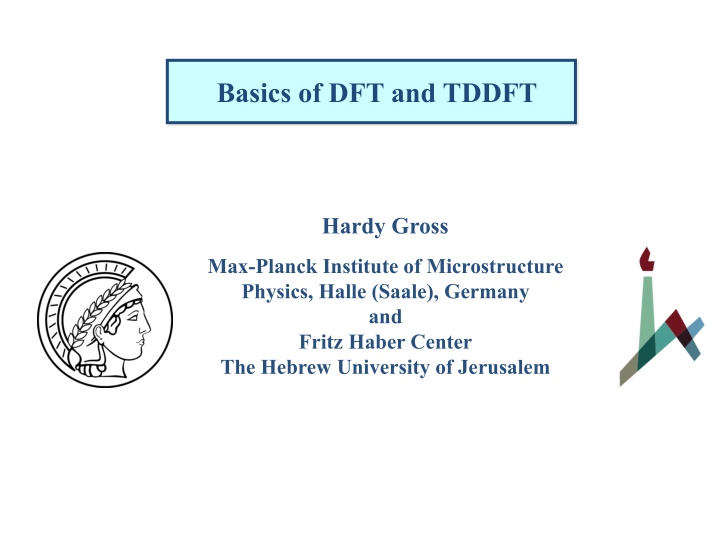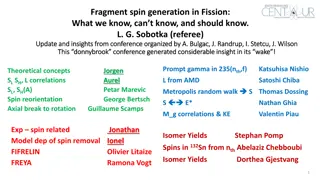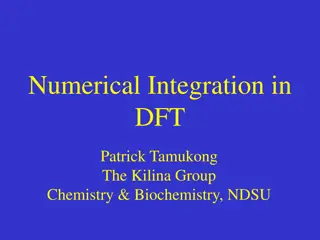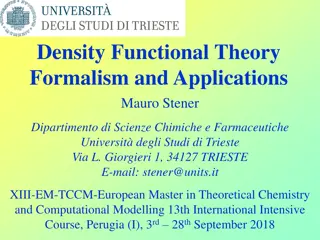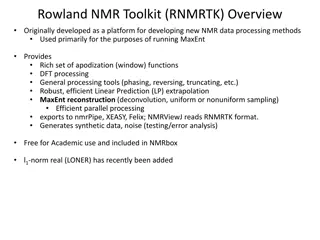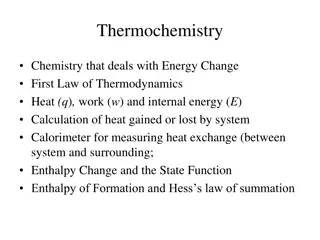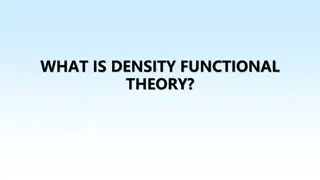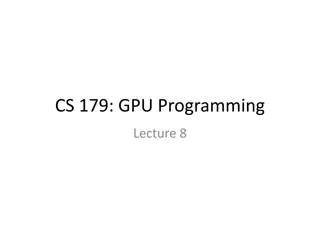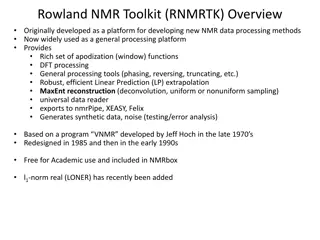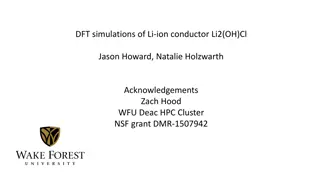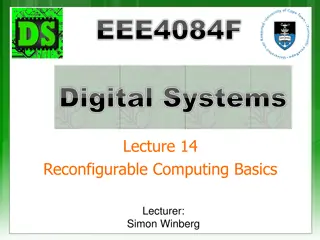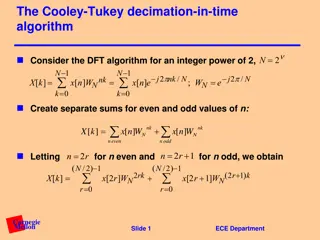Basics of DFT and TDDFT
Delve into the fundamentals of Density Functional Theory (DFT) and Time-Dependent Density Functional Theory (TDDFT) through the works of Hardy Gross, a prominent researcher at Max-Planck Institute of Microstructure Physics. Explore the Hamiltonian of condensed matter systems, including atoms, molecules, clusters, and solids. Understand the stationary Schrödinger equation and the time-dependent Schrödinger equation in the context of complete electron and nuclei systems. Discover concepts like the Born-Oppenheimer approximation and Adiabatic approximation for molecular wave functions.
Download Presentation

Please find below an Image/Link to download the presentation.
The content on the website is provided AS IS for your information and personal use only. It may not be sold, licensed, or shared on other websites without obtaining consent from the author.If you encounter any issues during the download, it is possible that the publisher has removed the file from their server.
You are allowed to download the files provided on this website for personal or commercial use, subject to the condition that they are used lawfully. All files are the property of their respective owners.
The content on the website is provided AS IS for your information and personal use only. It may not be sold, licensed, or shared on other websites without obtaining consent from the author.
E N D
Presentation Transcript
Basics of DFT and TDDFT Hardy Gross E.K.U. Gross Max-Planck Institute of Microstructure Physics, Halle (Saale), Germany and Fritz Haber Center Max-Planck Institute of Microstructure Physics Halle (Saale) The Hebrew University of Jerusalem
The Hamiltonian of Condensed Matter (atoms, molecules, clusters, solids)
Hamiltonian for the complete system of Ne electrons with coordinates and Nn nuclei with coordinates r r e N 1 ( ) r ( ) R R R 1 N n H T W T W V = + + + + ( R ) ( R ) ) r ( e ) r ( ee ( ) r , R n nn en Z Z M 2 2 N 2 N 2 i N 1 e n n = = i , T T W = = = with n e nn m 2 R R 1 1 N N N Z 1 1 e e n k , j = 1 j W V = = R ee en 2 r r r = 1 j k j j k
Hamiltonian for the complete system of Ne electrons with coordinates and Nn nuclei with coordinates r r e N 1 ( ) r ( ) R R R 1 N n H T W T W V = + + + + ( R ) ( R ) ) r ( e ) r ( ee ( ) r , R n nn en Z Z M 2 2 N 2 N 2 i N 1 e n n = = i , T T W = = = with n e nn m 2 R R 1 1 N N N Z 1 1 e e n k , j = 1 j W V = = R ee en 2 r r r = 1 j k j j k Stationary Schr dinger equation ( R , r = ) ( ) H E , r R
Hamiltonian for the complete system of Ne electrons with coordinates and Nn nuclei with coordinates r r e N 1 ( ) r ( ) R R R 1 N n H T W T W V = + + + + ( R ) ( R ) ) r ( e ) r ( ee ( ) r , R n nn en Z Z M 2 2 N 2 N 2 i N 1 e n n = = i , T T W = = = with n e nn m 2 R R 1 1 N N N Z 1 1 e e n k , j = 1 j W V = = R ee en 2 r r r = 1 j k j j k Time-dependent Schr dinger equation ( R , r H t , R , r t = = ) ( ( ) ( , r ) ) ( ) = + i V R t , , r R t , laser N N ( , r ) ( ) t e n V R t , r Z R E f cos t laser j 1 = j 1
Born-Oppenheimer approximation Neglect nuclear kinetic energy in full Hamiltonian ( ) ( ) r ( ) r ( ) R T (r) e + + W (R) V (r,R) + = J BO R BO R BO W (r) ee en nn ,J ,J R . To be solved for each fixed nuclear configuration ( ) R BO J J=1 J=0 R
Adiabatic approximation for the complete molecular wave function: ( ) ( ) r ( ) R = BO BO R BO , r R find best BO by minimizing < BO | H | BO > w.r.t. BO
Nuclear equation 1 (-i ( ) R A ( ) R T (R) n + + ) + W (R) nn BO BO M ( ) T r ( ) R ( ) r ( ) R ( ) R + E = BO R * BO R BO BO r d n Berry connection ( ) R A ( ) r ( ) r = BO BO R * BO R (-i ) d r ( ) R ( ) C = BO BO A d R is a geometric phase C corresponding to interesting topological features of molecules ( ) R BO expansion of to second order around equilibrium positions yields phonon spectrum
Lectures I+II+III: Focus on the electronic-structure problem, for static and time-dependent systems, but with clamped nuclei (i.e. Born-Oppenheimer approximation): T (r) e = + + W (R) V (r,R) + BO H (r,R) W (r) ee en nn R . with fixed nuclear coordinates
Lectures I+II+III: Focus on the electronic-structure problem, for static and time-dependent systems, but with clamped nuclei (i.e. Born-Oppenheimer approximation): T (r) e = + + W (R) V (r,R) + BO H (r,R) W (r) ee en nn R . with fixed nuclear coordinates This is still an exponentially hard problem! Lecture I: Ground-state DFT, basic concepts Lecture II: Approximate xc functionals Lecture III: Time-dependent DFT, linear response and beyond Lecture IV: Electron-nuclear coupling beyond Born-Oppenheimer
Why dont we just solve the many-body Schr dinger equation Example: Oxygen atom (8 electrons) ( ) 8 1 r , , r depends on 24 coordinates rough table of the wavefunction 10 entries per coordinate: 1 byte per entry: 5 109 bytes per DVD: 10 g per DVD: 1024 entries 1024 bytes 2 1014 DVDs 2 1015 g of DVDs = 2 109 t of DVDs
Two fundamentally different classes of ab-initio approaches: Wave function approaches -- Configuration interaction (also stochastic CI) -- Tensor networks Functional Theories
Two fundamentally different classes of ab-initio approaches: Wave function approaches -- Configuration interaction (also stochastic CI) -- Tensor networks Functional Theories Write total energy as functional of a simpler quantity and minimize
Motivation Functional Theories DFT MBPT RDMFT + = ) r ( = ) r , r ( (r,r') G(r,r',0 ) t , ' r , r ( G ) ' t
Motivation Functional Theories DFT MBPT RDMFT + = ) r ( = ) r , r ( (r,r') G(r,r',0 ) t , ' r , r ( G ) ' t Functional: xc[G] or xc[G] Functional: Exc[ ] Functional: Exc[ ] or vxc[ ]
Motivation Functional Theories DFT MBPT RDMFT + = ) r ( = ) r , r ( (r,r') G(r,r',0 ) t , ' r , r ( G ) ' t Functional: xc[G] or xc[G] easy (e.g. GW) Functional: Exc[ ] Functional: Exc[ ] or vxc[ ] very difficult difficult
Motivation Functional Theories DFT MBPT RDMFT + = ) r ( = ) r , r ( (r,r') G(r,r',0 ) t , ' r , r ( G ) ' t Functional: xc[G] or xc[G] easy (e.g. GW) numerically heavy Functional: Exc[ ] Functional: Exc[ ] or vxc[ ] very difficult difficult moderate light
ESSENCE OF DENSITY-FUNTIONAL THEORY Every observable quantity of a quantum system can be calculated from the density of the system ALONE The density of particles interacting with each other can be calculated as the density of an auxiliary system of non-interacting particles
ESSENCE OF DENSITY-FUNTIONAL THEORY Every observable quantity of a quantum system can be calculated from the density of the system ALONE The density of particles interacting with each other can be calculated as the density of an auxiliary system of non-interacting particles Hohenberg-Kohn theorem (1964) Kohn-Sham theorem (1965) (for the ground state)
DFT papers per year Jul 5th, 2017 DFT: A Theory Full of Holes, Aurora Pribram-Jones, David A. Gross, Kieron Burke, Annual Review of Physical Chemistry (2014). KITS 20
HOHENBERG-KOHN THEOREM 1 1 1. v(r) (r) one-to-one correspondence between external potentials v(r) and ground-state densities (r). In other words: v(r) is a functional of (r) 2. Variational principle Given a particular system characterized by the external potential v0(r). There exists a functional, EHK [ ], such that the solution of the Euler-Lagrange equation 0 E r = ( ) HK yields the exact ground-state energy E0 and ground-state density 0(r) of this system 3. EHK = F + (r) v0(r) d3r F is UNIVERSAL.
compare ground-state densities (r) resulting from different external potentials v(r). (r) v(r) QUESTION: Are the ground-state densities coming from different potentials always different?
G A (r) v(r) (r1 rN) single-particle potentials having nondegenerate ground state ground-state densities ground-state wavefunctions Hohenberg-Kohn-Theorem (1964) G: v(r) (r) is invertible
Proof Step 1: Invertibility of map A Solve many-body Schr dinger equation for the external potential: ( ) T W E V = ee T ( ) r N ( ) constant + = = v W r ... r j ee 1 N j 1 This is manifestly the inverse map: A given uniquely yields the external potential.
Step 2: Invertibility of map Given: two (nondegenerate) ground states , satisfying H H T T W W + V V H H = = + + + = E with = ' ' ' ' ' E ' ' ' to be shown: = cannot happen
Use Rayleigh-Ritz principle: H H = = + E ' ' ' H ' V V ' ' ( ) ( ) v r ( ) r = + ' E d r ' r ' v 3 H H = ' E ' ' ' ' ' v ( ) r ( ) r ( ) r = + E d r v 3 Reductio ad absurdum: Assumption = . Add and E + E < E + E
Consequence Every quantum mechanical observable is completely determined by the ground state density. 1 G solve . E . S v Proof: i B B = B Hermitian operator i i i e.g. excitation spectrum: Ei[ ]
What is a FUNCTIONAL? E[ ] R R (r) functional set of functions set of real numbers Generalization: = ( ) functional depending parametrically on r rv v r = ( ) ( ) r...r 1 r ... r or on 1 r ...r 1 N N N
QUESTION: ( ) r V How to calculate ground state density (characterized by the external potential without recourse to the Schr dinger Equation? of a given system ) ( ) r o v o = o Theorem: There exists a density functional EHK[ ] with properties i) EHK[ ] > Eo for o ii) EHK[ o] = Eo where Eo = exact ground state energy of the system 0 = E Thus, Euler equation ( ) r HK yields exact ground state density o.
proof: formal construction of EHK[ ] : r A~ ( ) 1 for arbitrary ground state density HK E T W V + + define: o > Eo for o = Eo for = o q.e.d. T W + EHK[ ] = d3r (r) vo(r) + F[ ] is universal
An Example: Explicit algorithm to construct the HK map vs for non-interacting particles h2 2 ( + vs(r) ) i = i i 2m i* i N N h2 2 i*( ) i + vs(r) (r) = 2m i = 1 i i = 1 i(r) 2 N 1 h2 2 2m vs(r) = ( i (r) i(r) 2 i* (- ) i) i = 1 Iterative procedure 0(r) given (e.g. from experiment) Start with an initial guess for vs(r) (e.g. LDA potential) h2 2 solve ( + vs(r) ) i = i i 2m N 1 h2 2 2m vsnew(r) = ( i i(r) 2 i* (- ) i) 0( r) i = 1 solve SE with vsnew and iterate, keeping 0(r) fixed Consequence: The orbitals are functionals of the density: i[ ]
KOHN-SHAM EQUATIONS EHK = TS + (r) v0(r) d3r + EH[ + xc ( )( j j r / 2 Rewrite HK functional: S T ) ( ) = 3 2 d r r where is the kinetic energy functional of non-interacting particles 0 = E yields the Kohn-Sham equations: ( ) r HK ( ) ( ) r ( ) r ( ) r ( ) r ( ) r + + + = 2 / 2 v v [ ] v [ ] j j j 0 H xc The orbitals from these equations yield the true density of the interacting system Walter Kohn: The KS equations are an exactification of the Hartree mean-field equation Exc[ ] is a universal functional of the density which, in practice, needs to be approximated.
The functional Exc[ ] is universal: Curse or blessing?
The functional Exc[ ] is universal: Curse or blessing? Only ONE functional needs to be approximated
The functional Exc[ ] is universal: Curse or blessing? Only ONE functional needs to be approximated Functional can be systematically improved, i.e. results will improve -on average- for all systems. Systematic improvement for a single given system is not possible.
The five levels of (TD)DFT Level 1: Basic Theorems Level 2: Deduce exact features of the xc functional ( ) ( ) v r't' rt Level 3: Find approximate functionals for xc Level 4: Write code that solves the (TD)KS equations Level 5: Run code for interesting systems/questions
